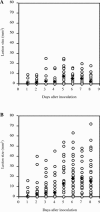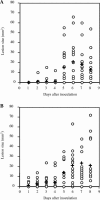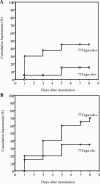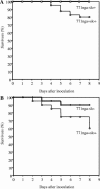Role of NADase in virulence in experimental invasive group A streptococcal infection
- PMID: 16177331
- PMCID: PMC1230891
- DOI: 10.1128/IAI.73.10.6562-6566.2005
Role of NADase in virulence in experimental invasive group A streptococcal infection
Abstract
Group A streptococci (GAS) produce several exoproteins that are thought to contribute to the pathogenesis of human infection. Two such proteins, streptolysin O (SLO) and NAD(+)-glycohydrolase (NADase), have been shown to interact functionally as a compound signaling toxin. When GAS are bound to the surface of epithelial cells in vitro, SLO forms pores in the cell membrane and delivers NADase to the epithelial cell cytoplasm. In vitro, intoxication of keratinocytes with NADase is associated with cytotoxic effects and induction of apoptosis; however, the importance of NADase during infection of an animal host has not been established. We employed isogenic GAS mutants to assess the contribution of NADase activity to GAS virulence in vivo using mouse models of invasive soft-tissue infection and septicemia. In both models, mutant GAS that lacked NADase activity were significantly attenuated for virulence compared with the isogenic wild-type parent, confirming an important role for NADase in the infection of a host animal. A double mutant lacking SLO and NADase activity had an intermediate virulence phenotype, consistent with the hypothesis that SLO evokes a protective innate immune response. We conclude that NADase and SLO together enhance GAS virulence in vivo.
Figures





Similar articles
-
NAD+-Glycohydrolase Promotes Intracellular Survival of Group A Streptococcus.PLoS Pathog. 2016 Mar 3;12(3):e1005468. doi: 10.1371/journal.ppat.1005468. eCollection 2016 Mar. PLoS Pathog. 2016. PMID: 26938870 Free PMC article.
-
Binding of NAD+-Glycohydrolase to Streptolysin O Stabilizes Both Toxins and Promotes Virulence of Group A Streptococcus.mBio. 2017 Sep 12;8(5):e01382-17. doi: 10.1128/mBio.01382-17. mBio. 2017. PMID: 28900022 Free PMC article.
-
Structure of the Streptococcus pyogenes NAD+ Glycohydrolase Translocation Domain and Its Essential Role in Toxin Binding to Oropharyngeal Keratinocytes.J Bacteriol. 2022 Jan 18;204(1):e0036621. doi: 10.1128/JB.00366-21. Epub 2021 Oct 25. J Bacteriol. 2022. PMID: 34694903 Free PMC article.
-
Streptolysin S-like virulence factors: the continuing sagA.Nat Rev Microbiol. 2011 Aug 8;9(9):670-81. doi: 10.1038/nrmicro2624. Nat Rev Microbiol. 2011. PMID: 21822292 Free PMC article. Review.
-
Is streptolysin S of group A streptococci a virulence factor?APMIS. 1999 Dec;107(12):1051-9. doi: 10.1111/j.1699-0463.1999.tb01509.x. APMIS. 1999. PMID: 10660134 Review.
Cited by
-
NAD+-Glycohydrolase Promotes Intracellular Survival of Group A Streptococcus.PLoS Pathog. 2016 Mar 3;12(3):e1005468. doi: 10.1371/journal.ppat.1005468. eCollection 2016 Mar. PLoS Pathog. 2016. PMID: 26938870 Free PMC article.
-
Intergenic Variable-Number Tandem-Repeat Polymorphism Upstream of rocA Alters Toxin Production and Enhances Virulence in Streptococcus pyogenes.Infect Immun. 2016 Jun 23;84(7):2086-2093. doi: 10.1128/IAI.00258-16. Print 2016 Jul. Infect Immun. 2016. PMID: 27141081 Free PMC article.
-
NAD-Glycohydrolase Depletes Intracellular NAD+ and Inhibits Acidification of Autophagosomes to Enhance Multiplication of Group A Streptococcus in Endothelial Cells.Front Microbiol. 2018 Aug 3;9:1733. doi: 10.3389/fmicb.2018.01733. eCollection 2018. Front Microbiol. 2018. PMID: 30123194 Free PMC article.
-
Gene fitness landscape of group A streptococcus during necrotizing myositis.J Clin Invest. 2019 Feb 1;129(2):887-901. doi: 10.1172/JCI124994. Epub 2019 Jan 22. J Clin Invest. 2019. PMID: 30667377 Free PMC article.
-
Kynurenine Pathway of Tryptophan Metabolism: Regulatory and Functional Aspects.Int J Tryptophan Res. 2017 Mar 15;10:1178646917691938. doi: 10.1177/1178646917691938. eCollection 2017. Int J Tryptophan Res. 2017. PMID: 28469468 Free PMC article. Review.
References
-
- Ajdic, D., W. M. McShan, D. J. Savic, D. Gerlach, and J. J. Ferretti. 2000. The NAD-glycohydrolase (nga) gene of Streptococcus pyogenes. FEMS Microbiol. Lett. 191:235-241. - PubMed
-
- Alouf, J. E., and C. Geoffroy. 1991. The family of the antigenically-related cholesterol-binding (“sulphydryl-activated”) cytolytic toxins, p. 147-186. In J. E. Alouf and J. H. Freer (ed.), Sourcebook of bacterial toxins. Academic Press, London, United Kingdom.
-
- Bricker, A. L., C. Cywes, C. D. Ashbaugh, and M. R. Wessels. 2002. NAD+-glycohydrolase acts as an intracellular toxin to enhance the extracellular survival of group A streptococci. Mol. Microbiol. 44:257-269. - PubMed
-
- Davies, H. D., A. McGeer, B. Schwartz, K. Green, D. Cann, A. E. Simor, D. E. Low, and the O. G. A. S. S. Group. 1996. Invasive group A streptococcal infections in Ontario, Canada. N. Engl. J. Med. 335:547-554. - PubMed
Publication types
MeSH terms
Substances
Grants and funding
LinkOut - more resources
Full Text Sources
Medical
Molecular Biology Databases

